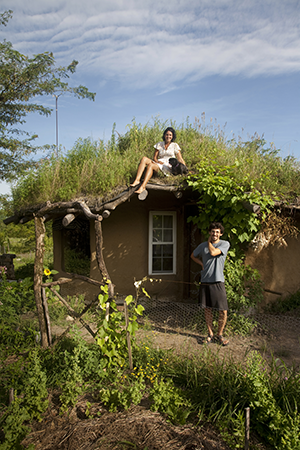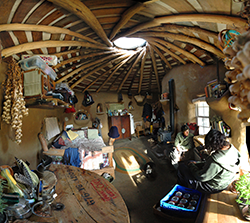One Alum’s Cob House is a Natural Fit
Brian Liloia is living in a Missouri cob house that he conceived and built himself, literally from the ground up, using a mixture of sand, clay, and straw.


Brian Liloia ’06 wasn’t the first suburbanite to depart a close-quarters neighborhood and make a new home for himself, but he may have taken it to a new level.
Liloia, 26, has reason to be especially proud of his adopted residence—a Missouri cob house that he conceived and built himself, literally from the ground up. The house, which Liloia crafted from a mixture of sand, clay, and straw, resides in the Dancing Rabbit Ecovillage, a 50-person rural community dedicated to ecologically sustainable living.
Liloia first visited Dancing Rabbit three weeks after graduation, and decided within a year that he wanted to build his first home there.
“The inspiration had come from a lot of learning about environment issues and social issues and deciding that I wanted to figure out how to live more sustainably, more ecologically, with like-minded people,” he said. Studying at the College, he considered a career in video and filmmaking, but admitted, “Even then, I knew that I didn’t really want to have a standard career…. I wanted a different kind of life.”
The lifestyle he forged in northeastern Missouri is a far cry from his native East Rutherford or TCNJ’s dorms. His abode, which bears the larger-than-life nickname, “Gobcobatron,” lacks electricity—an aspect he purposefully excluded—but the multi-room house is decked with shelves and all the essential furniture, fixed with windows and doors, and topped by a green head of hair (a living roof).
Since Gobcobatron became habitable in July 2009, Liloia has embraced a seasonal pattern: springtime sees him working in his adjacent garden, processing food, and working on construction for village homes, including his own. The cob house is a work in progress. Liloia and his girlfriend and co-resident, April, are currently working on a kitchen addition.

“Winter is more quiet,” Liloia said. It’s a time for relaxation, reading and making plans, he said, but it has also brought him challenges. Cob does not insulate well, and temperatures and moisture have led him to reconsider his choice of material in the northern Missouri climate. It is likely, he said, that they will build a new house, renovating Gobcobatron for a more efficient use.
Still, Liloia has a lot of love for his project. He blogs about his experience at small-scale.net/yearofmud, and offers work-exchange opportunities in natural building and gardening—visiting helpers were essential to the initial construction. His site offers a recipe for building a cob house with $3,000, and he is considering writing a book about his experience.
“It was just really empowering,” he said. “If I could do this with very little building experience, I think most people can do it too.”
He’s also quite at home in the Dancing Rabbit community. He praised the dynamic of the ecovillage in comparison to the more isolated suburbs, where the houses are closer together, but the people might not be.
“It’s definitely a lesson in learning how to communicate and learning how to respect differences,” he said. “In the suburbs, you could basically live your whole life without knowing any of your neighbors and just ignoring them if you want to.” In his Missouri prairie community, Liloia said, those with a common mission learn to work together.
“You’re going to depend on those people, and they’re going to depend on you,” he said.
Click here to see more photos of Liloia’s cob house.
Posted on April 12, 2011

